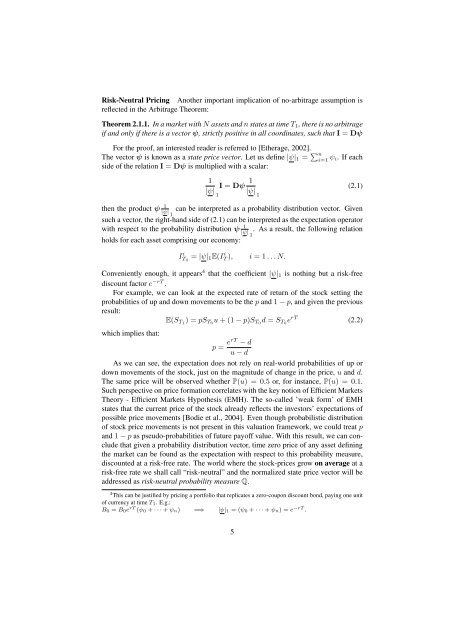sparse grid method in the libor market model. option valuation and the
sparse grid method in the libor market model. option valuation and the
sparse grid method in the libor market model. option valuation and the
You also want an ePaper? Increase the reach of your titles
YUMPU automatically turns print PDFs into web optimized ePapers that Google loves.
Risk-Neutral Pric<strong>in</strong>g Ano<strong>the</strong>r important implication of no-arbitrage assumption is<br />
reflected <strong>in</strong> <strong>the</strong> Arbitrage Theorem:<br />
Theorem 2.1.1. In a <strong>market</strong> with N assets <strong>and</strong> n states at time T 1 , <strong>the</strong>re is no arbitrage<br />
if <strong>and</strong> only if <strong>the</strong>re is a vector ψ, strictly positive <strong>in</strong> all coord<strong>in</strong>ates, such that I = Dψ<br />
For <strong>the</strong> proof, an <strong>in</strong>terested reader is referred to [E<strong>the</strong>rage, 2002].<br />
The vector ψ is known as a state price vector. Let us def<strong>in</strong>e |ψ| 1 = ∑ n<br />
i=1 ψ i. If each<br />
side of <strong>the</strong> relation I = Dψ is multiplied with a scalar:<br />
1<br />
I = Dψ 1<br />
(2.1)<br />
|ψ| 1<br />
|ψ| 1<br />
<strong>the</strong>n <strong>the</strong> product ψ 1<br />
|ψ| 1<br />
can be <strong>in</strong>terpreted as a probability distribution vector. Given<br />
such a vector, <strong>the</strong> right-h<strong>and</strong> side of (2.1) can be <strong>in</strong>terpreted as <strong>the</strong> expectation operator<br />
with respect to <strong>the</strong> probability distribution ψ 1<br />
|ψ| 1<br />
. As a result, <strong>the</strong> follow<strong>in</strong>g relation<br />
holds for each asset compris<strong>in</strong>g our economy:<br />
I i T 0<br />
= |ψ| 1 E(I i T ), i = 1 . . . N.<br />
Conveniently enough, it appears 4 that <strong>the</strong> coefficient |ψ| 1 is noth<strong>in</strong>g but a risk-free<br />
discount factor e −rT .<br />
For example, we can look at <strong>the</strong> expected rate of return of <strong>the</strong> stock sett<strong>in</strong>g <strong>the</strong><br />
probabilities of up <strong>and</strong> down movements to be <strong>the</strong> p <strong>and</strong> 1 − p, <strong>and</strong> given <strong>the</strong> previous<br />
result:<br />
E(S T1 ) = pS T0 u + (1 − p)S T0 d = S T0 e rT (2.2)<br />
which implies that:<br />
p = erT − d<br />
u − d<br />
As we can see, <strong>the</strong> expectation does not rely on real-world probabilities of up or<br />
down movements of <strong>the</strong> stock, just on <strong>the</strong> magnitude of change <strong>in</strong> <strong>the</strong> price, u <strong>and</strong> d.<br />
The same price will be observed whe<strong>the</strong>r P(u) = 0.5 or, for <strong>in</strong>stance, P(u) = 0.1.<br />
Such perspective on price formation correlates with <strong>the</strong> key notion of Efficient Markets<br />
Theory - Efficient Markets Hypo<strong>the</strong>sis (EMH). The so-called ’weak form’ of EMH<br />
states that <strong>the</strong> current price of <strong>the</strong> stock already reflects <strong>the</strong> <strong>in</strong>vestors’ expectations of<br />
possible price movements [Bodie et al., 2004]. Even though probabilistic distribution<br />
of stock price movements is not present <strong>in</strong> this <strong>valuation</strong> framework, we could treat p<br />
<strong>and</strong> 1 − p as pseudo-probabilities of future payoff value. With this result, we can conclude<br />
that given a probability distribution vector, time zero price of any asset def<strong>in</strong><strong>in</strong>g<br />
<strong>the</strong> <strong>market</strong> can be found as <strong>the</strong> expectation with respect to this probability measure,<br />
discounted at a risk-free rate. The world where <strong>the</strong> stock-prices grow on average at a<br />
risk-free rate we shall call “risk-neutral” <strong>and</strong> <strong>the</strong> normalized state price vector will be<br />
addressed as risk-neutral probability measure Q.<br />
4 This can be justified by pric<strong>in</strong>g a portfolio that replicates a zero-coupon discount bond, pay<strong>in</strong>g one unit<br />
of currency at time T 1 . E.g.:<br />
B 0 = B 0 e rT (ψ 0 + · · · + ψ n ) =⇒ |ψ| 1 = (ψ 0 + · · · + ψ n ) = e −rT .<br />
5
















